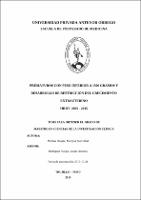Mostrar el registro sencillo del ítem
Prematuros con peso inferior a 1500 gramos y desarrollo de restricción del crecimiento extrauterino HRDT 2005 - 2015
| dc.contributor.advisor | Rodríguez Vargas, Javier Antonio | |
| dc.contributor.author | Medina Huayta, Mareyke Natividad | |
| dc.creator | Medina Huayta, Mareyke Natividad | |
| dc.date.accessioned | 2019-11-07T15:19:29Z | |
| dc.date.available | 2019-11-07T15:19:29Z | |
| dc.date.issued | 2019 | |
| dc.identifier.uri | https://hdl.handle.net/20.500.12759/5605 | |
| dc.description.abstract | Establecer factores de riesgo para RCEU es relevante para disminuir su frecuencia, RCEU se define por peso ≤ percentil 10 del esperado para la edad gestacional corregida en las curvas de Fenton. Objetivo: Determinar si en prematuros el peso al nacer inferior a 1500 g está asociado con el desarrollo de restricción del crecimiento extrauterino HRDT período 2005 – 2015. Material y métodos: Estudio de cohortes histórica cerrada, incluyó 73 prematuros con peso al nacer <1500 g (grupo I) y 219 con peso ≥1500 g (grupo II), muestra con 95% de confianza, 80% de potencia, riesgo de expuestos 0.76 y razón 1:3. Se evalúo la asociación estimando RR con IC 95%. Resultados: Tuvieron RCEU 80.7% de pacientes del grupo I y 40.7% del grupo II. El RR del peso <1500 g para desarrollar RCEU al alta fue 1.989 IC 95% [1.636 – 2.417]. El modelo de regresión logística consideró significativo el efecto de ausencia de nutrición precoz sobre la asociación estudiada (p=0.000). Conclusiones: Los prematuros con peso al nacer <1500 g tienen el doble de riesgo de desarrollar RCEU al alta y en ausencia de nutrición precoz este riesgo se incrementa. Palabras claves: Restricción del crecimiento extrauterino, peso inferior 1500 g, prematuridad. | es_PE |
| dc.description.abstract | Establishing risk factors for EUGR is relevant to decrease its frequency, EUGR is defined by weight ≤ 10th percentile of the expected for the corrected gestational age in the Fenton curves. Objective: To determine if the weight of less than 1500 grams is associated with development of extrauterine growth restriction in premature infants in HRTD period 2005 - 2015. Material and method: Historical closed cohort study, study included 73 premature infants with weight <1500 g (group I) and 219 with weight ≥1500 g (group II), sample determined with 95% confidence, 80% power, risk of exposed 0.76 and 1:3 ratios The association was evaluated by estimating RR with 95% CI. Results: 80.7% of patients in group I and 40.7% of patients in group II had EUGR. RR of weight < 1500 gr for development of EUGR was 1.989 with 95% CI [1.636 – 2.417]. The logistic regression model considered the effect of absence of early nutrition on the association studied significant (p = 0.000). Conclusions: Premature infants with weight <1500 grams have twice risk of developing EUGR than those with weight ≥1500 grams and in absence of early nutrition, this risk is significantly increased. Keywords: Extrauterine growth restriction, weight less than 1500 g, premature infants. | en_US |
| dc.description.uri | Tesis | es_PE |
| dc.format | application/pdf | es_PE |
| dc.language.iso | spa | es_PE |
| dc.publisher | Universidad Privada Antenor Orrego - UPAO | es_PE |
| dc.relation.ispartofseries | T_MAEST.MEDE_058 | |
| dc.rights | info:eu-repo/semantics/openAccess | es_PE |
| dc.source | Universidad Privada Antenor Orrego | es_PE |
| dc.source | Repositorio Institucional - UPAO | es_PE |
| dc.subject | Peso | es_PE |
| dc.subject | Extrauterino | es_PE |
| dc.title | Prematuros con peso inferior a 1500 gramos y desarrollo de restricción del crecimiento extrauterino HRDT 2005 - 2015 | es_PE |
| dc.type | info:eu-repo/semantics/masterThesis | es_PE |
| thesis.degree.level | Maestría | es_PE |
| thesis.degree.grantor | Universidad Privada Antenor Orrego. Escuela de Postgrado | es_PE |
| thesis.degree.name | Maestro en Ciencias en Investigación Clínica | es_PE |
| thesis.degree.discipline | Maestría en Ciencias en Investigación Clínica | es_PE |

